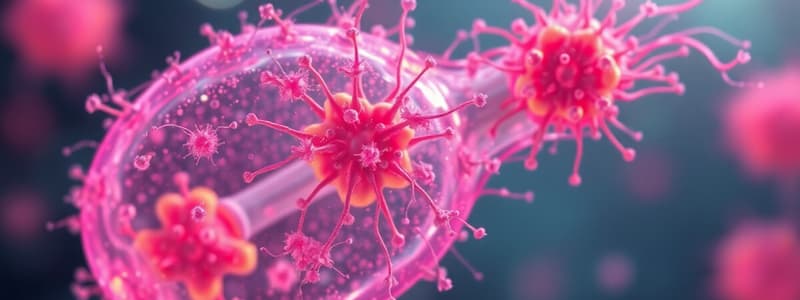Podcast
Questions and Answers
Which characteristic distinguishes protozoa from organisms in other kingdoms?
Which characteristic distinguishes protozoa from organisms in other kingdoms?
- Ability to perform photosynthesis
- Unicellular eukaryotic organization (correct)
- Presence of membrane-bound organelles
- Mode of reproduction involving meiosis
A protozoan is observed moving with a large, blunt pseudopodium. Which type of pseudopodium is most likely being used?
A protozoan is observed moving with a large, blunt pseudopodium. Which type of pseudopodium is most likely being used?
- Lobopodia (correct)
- Filopodia
- Reticulopodia
- Axopodia
Which method of reproduction leads to increased genetic diversity in protozoa?
Which method of reproduction leads to increased genetic diversity in protozoa?
- Conjugation (correct)
- Schizogony
- Binary fission
- Budding
An unfamiliar parasitic protozoan is found in a patient displaying symptoms of sleeping sickness. Which genus is the most likely suspect?
An unfamiliar parasitic protozoan is found in a patient displaying symptoms of sleeping sickness. Which genus is the most likely suspect?
A protozoan sample is observed to have both a macronucleus and a micronucleus. To which sub-phylum does it belong?
A protozoan sample is observed to have both a macronucleus and a micronucleus. To which sub-phylum does it belong?
Which protozoan sub-phylum exclusively contains parasitic species that lack specialized locomotory structures?
Which protozoan sub-phylum exclusively contains parasitic species that lack specialized locomotory structures?
Which structure is common to both flagella and cilia?
Which structure is common to both flagella and cilia?
Considering their modes of locomotion, which protozoan is least likely to be found freely suspended in open water?
Considering their modes of locomotion, which protozoan is least likely to be found freely suspended in open water?
An organism possesses chloroplasts and flagella. Which of the following genera does it most likely belong to?
An organism possesses chloroplasts and flagella. Which of the following genera does it most likely belong to?
Which protozoan is transmitted through contact with cats and dogs?
Which protozoan is transmitted through contact with cats and dogs?
Flashcards
Protozoa
Protozoa
Single-celled eukaryotic organisms, ranging from 3 to 1,000 microns. They lack germ layers, tissues, and organs but possess specialized intracellular organelles.
Pseudopodia
Pseudopodia
Extensions of cytoplasm consisting of rigid ectoplasm and less rigid endoplasm, allowing for movement.
Sarcodina
Sarcodina
Protozoa sub-phylum that moves using pseudopodia. They have a single nucleus or monomorphic nuclei.
Mastigophora
Mastigophora
Signup and view all the flashcards
Apicomplexa
Apicomplexa
Signup and view all the flashcards
Ciliophora (Ciliates)
Ciliophora (Ciliates)
Signup and view all the flashcards
Axoneme
Axoneme
Signup and view all the flashcards
Plasmodium
Plasmodium
Signup and view all the flashcards
Trypanosoma
Trypanosoma
Signup and view all the flashcards
Giardia
Giardia
Signup and view all the flashcards
Study Notes
- Protozoa are single-celled eukaryotic organisms.
- They range from 3 to 1,000 microns in size, they are microscopic.
- They lack germ layers, tissues, and organs.
- Protozoa possess specialized intracellular organelles.
- They exhibit various symmetries: bilateral, radial, spherical, and asymmetrical.
- Protozoa have diverse life habits: free-living, commensal, parasitic, or mutualistic.
- Most protozoa species are naked, but some have protective exoskeletons called tests.
- Protozoa nutrition can be autotrophic (holophytic), saprozoic, saprophytic, or holozoic.
- Protozoa move using pseudopodia, flagella, or cilia.
- They reproduce both asexually and sexually.
- Asexual reproduction includes binary fission, multiple fission (sporogony & schizogony), and budding.
- Sexual reproduction methods include syngamy, autogamy, and conjugation.
Classification of Protozoa
- Protozoa are classified into four sub-phyla: Sarcodina, Mastigophora, Apicomplexa, and Ciliophora.
Sub-Phylum Sarcodina
- Sarcodina are amoeba-like organisms that move using pseudopodia.
- They have a single nucleus or monomorphic nuclei.
- Examples include Amoeba (naked and free-living), Arcella (possesses a calcareous test and is free-living), and Entamoeba (lacks a test).
- Pseudopodia are extensions of the cytoplasm, consisting of a rigid ectoplasm (gel state) and a less rigid endoplasm (sol state).
- Alternation between these states allows for pseudopodial extension.
- Types of pseudopodia are: Lobopodia (large and blunt), Filopodia (thin extensions), Reticulopodia (thin extensions forming a mesh), and Axopodia (long and thin, supported by an axial filament).
Sub-Phylum Mastigophora
- Mastigophora use one or two flagella for movement.
- They have a single nucleus or monomorphic nuclei.
- Some are photosynthetic (with chloroplasts), while others are mutualistic or parasitic.
- Most are bilaterally symmetrical.
- Examples include Euglena (contains chloroplasts), Trypanosoma (heterotrophic and parasitic, causing sleeping sickness), Leishmania (causes leishmaniasis), Giardia (causes giardiasis/stomach infection), and Volvox (a colonial species).
Sub-Phylum Apicomplexa
- Apicomplexa lack locomotory structures and are all parasitic.
- Asexual reproduction involves multiple fission (schizogony).
- Plasmodium, the causative agent of malaria, is a key example, with types like Plasmodium vivax, ovale, malariae, and falciparum.
- Plasmodium falciparum is the most virulent, causing over 50% of the global malaria burden.
- Toxoplasma gondii causes toxoplasmosis, an opportunistic infection affecting immunocompromised individuals, transmitted through contact with cats and dogs.
Sub-Phylum Ciliophora (Ciliates)
- Ciliophora move using cilia and usually possess two sizes of nuclei: macronucleus and micronucleus.
- Reproduction occurs asexually through transverse binary fission and sexually through conjugation.
- Examples include Paramecium, Vorticella, and Stentor.
- Flagella and cilia share a similar internal structure called an axoneme, consisting of a 9+2 arrangement of microtubules, providing strength.
- Flagella are generally longer and fewer, while cilia are shorter and more numerous.
Studying That Suits You
Use AI to generate personalized quizzes and flashcards to suit your learning preferences.




